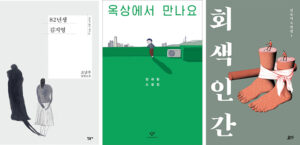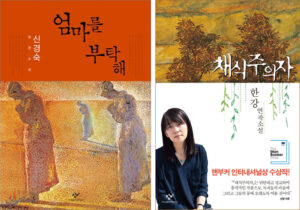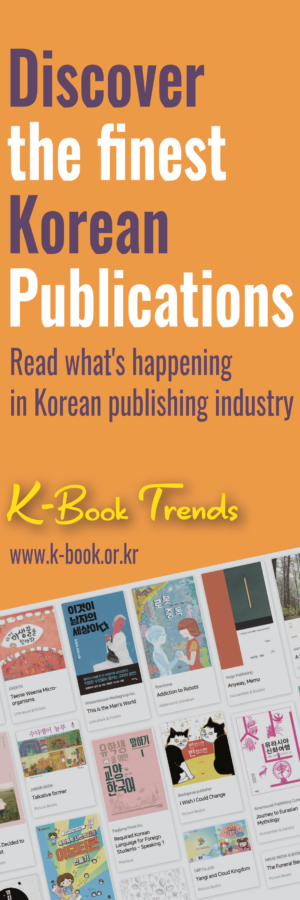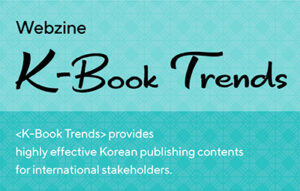Current status of each field in the Korean publishing market
① Literature publication
2020.02.03

Interesting stories from the past will always attract people’s minds; literature was the beginning and the flower of publication in every country. The poems, novels, essays, and plays written in Korean by Korean authors that sublimate their identity, emotions, and critical minds are an irreplaceable pillar of Korean culture. In particular, while undergoing turbulent modern history including the Japanese colonization, the Korean War, military dictatorship, industrialization, democratization, globalization, and informatization, Koreans would reflect the wounds in gemlike poems, novels, and essays, and share them in the form of a book. While not neglecting the pains of the time and standing against unjust authority, literature also played a role as an encourager that gave courage and hope to readers. Korean publication is also a resemblance of literature; it has been a medium in which readers can ask and contemplate about human beings and society, rather than being engulfed in excessive commercialism and entertainment.
The poems, novels, essays, and plays written in Korean by Korean authors that sublimate their identity, emotions, and critical minds are an irreplaceable pillar of Korean culture.
According to the Korean Publishers Association (KPA), a total of 13,346 new literary books were published in Korea in 2018. Among the 63,476 total number of prints, literature ranked the first in terms of per-field share, followed by social science (11,881), children’s books (7,289), and technology (7,193). Circulation of new literary books in 2018 hit approximately 14.26 million (14,259,651). Publication of literary books is continuing an uptrend; 8,718 books were recorded in 2009, 10,671 in 2014, 12,904 in 2017, and 13,346 in 2018. For each type of literature published in 2018, novels were 4,750, poems 2,193, essays 999, and plays 40. Poems, novels, and essays demonstrate that their productivity remains robust as the three main popular literary genres. Yet, the circulation per literary book was 1,068 as of 2018, which is failing to turn the persisted decline.
Foreign literary books translated and published in 2018 were 2,756 in total. Translated books among the newly published literary books account for about 21%. Korean literature was about 9,533, followed by Japanese literature (1,211), Britain and the US literature (837), French literature (188), and German literature (147), in which foreign literary works were also published in a comparable size. Foreign literature is highly popular in Korea. Japanese writers Higashino Keigo and Murakami Haruki, and French writers Bernard Werber and Guillaume Musso are the best examples. Their books, including both new and old, are steady sellers in the market, living up to their names.
According to a summary of the publishing industry survey and per-field share in Kyobo Bookstore by the Publication Industry Promotion Agency of Korea (KPIPA), the size of the literature publishing market in Korea is estimated to be worth about 150 billion won as of 2019, in which novels account for 51% and essays and poem books 49%. Based on the sales during recent years, novels have been losing share within the publishing market (8.5% in 2017, 7.9% in 2018, and 6.7% in 2019 based on Kyobo Bookstore), with essays and poem books slightly stagnating compared to the previous year (6.0% in 2017, 6.9% in 2018, and 6.4% in 2019 based on Kyobo Bookstore).
Relative stagnation of novels and uptrend of essays are due to the lack of novels that receive hot attention from readers. It is highly symbolic that the top three best sellers in 2019 were essays written by Korean writers (Kim Young-Ha, Hyemin Sunim, and Kim Soo-Hyeon). Literature took exactly half in the list of top 30 bestsellers, with 8 essays, 1 poem book, and 6 novels. Popular essays are mainly those that are light and heartwarming, which console and encourage the exhausted lives of their readers.
The recent biggest issue among Korean novels is feminism. The leading writers of this trend are Cho Nam-Joo, a million-seller writer with her book “Kim Ji Young, Born in 1982 (Minumsa)”, and Jung Se-Rang of “See You on the Rooftop (Changbi)”. More than 2 million copies of the book “Kim Ji Young, Born in 1982” were sold and the book was also made into a movie, which stood out to become a cultural phenomenon in Korea. The young women readers that doubt the Korean society in which the human rights of women have been relatively neglected inspired enthusiasm, saying that the story reflects their life. Also, novelist Kim Soom tenaciously covered the comfort women forcibly mobilized by the Japanese military, Kim Dong-Shik of “Gray Human Beings (Yoda Books)” that was highlighted with his fresh imagination, and also an increased number of novels that talk about homosexuality of men or women have been drawing attention from both inside and outside of the literary world in recent years.

“Kim Ji Young, Born in 1982”, ‘See You on the Rooftop”, “Gray Human Beings”
Meanwhile, both strong and experienced writers and rookie writers coexist in the Korean literature publishing industry. Major publishers that have been releasing novels and poem books mainly by Korean authors are Munhakdongne, Minumsa, Changbi, Hainaim, Moonji, and EunHaengnaMu. Creation & Criticism (original name of Changbi) began its history with the publication of a quarterly literary magazine titled “Creation & Criticism (shortened to “Changbi (chang means creation, and bi means criticism)”) in 1966, which then changed its name to “Changbi” in 2003. This legendary literary magazine that was sought by college students as a must-read during the 1970s was like a shrine for “engagement literature (progressive literature).” The book “Please Look After Mom” by Shin Kyung-Sook that won the Man Asian Literary Prize, and the book “The Vegetarian” by Han Kang that won the Man Booker International Prize were published by this company, receiving great attention at both home and abroad.

“Please Look After Mom”, “The Vegetarian”
Also, Minumsa, established in 1966, reflects in its name “to resist against the injustice of the time and pay upright heed to the voice of the people”. It became the strong leader in literature publication with the successive publication of “World Poet Collection”, “Poet of the Year Series”, and “Writer of the Year Series“. Moonji Publications that began with a quarterly literary magazine in 1975 built its reputation by steadily publishing both domestic and international novels and poems that have a high literary value. Munhakdongne was a late runner and opened in 1993, but it has become an influential publisher in the literature publishing market with the greatest number of literary books published today.
Open Books, Book Plaza, Woongjin Thinkbig, and D&C Media are publishers that focus on translated novels. Open Books is famous for world literature, Russian literature, and books by Umberto Eco, and Bernard Werber, and also for its unique book designs. Book Plaza mainly introduces genre fictions of foreign authors such as “The Irreversible Promise” by a Japanese writer Yakumaru Gaku, and “Ragdoll” by a British mystery writer Daniel Cole. Woongjin Thinkbig is a large publishing company that publishes complete collections for children; it published a translated series of “Penguin Classics”, expanding its influence in the market. Also, D&C Media translates and publishes not only comics but also Japanese light novels and Chinese martial arts novels.

“The Irreversible Promise”, “Ragdoll”
Many publishers in the market cover essays; leading publishers can be decided depending on the headline-making works they publish. The ones with good sales performance today are Wisdom House, Suo Books, Maumsup, and Sam & Parkers. The popularity of the author is critical more than anything else in terms of essay sales. In 2019, not only famous people such as novelist Kim Young-Ha, essayist Lee Ki-Joo, and actor Ha Jung-Woo but also essays written by stars on Social Media and Youtube were popular among people. With the essay boom that rose in recent years, the publication of related books has been quite active. According to the publishing industry trend announced by KPIPA, 4,282 poems, essays, and plays published in 2014 increased significantly to 7,064 in 2018.
Such a phenomenon is more vividly shown in Korea with advanced ICT technologies. Not only the media but also the standard for fun and storytelling itself are changing as well.
As the web-novel (online novel) market led by readers aged between 10s and 30s for the past decade grew rapidly, its size grew far larger than that of the paper book literature market. The openness that anyone can become a writer regardless of one’s skills and the accessibility that the content can be read anywhere and anytime with a smartphone is the best strengths. Some literature publishers jumped belatedly into this market, led by portal sites and e-book platforms, but they are struggling to shift the grand trend. Time and media are changing, and new wines are put into new wineskins. Smartphones began to replace literary books. Such a phenomenon is more vividly shown in Korea with advanced ICT technologies. Not only the media but also the standard for fun and storytelling itself are changing as well. Rather than serious or grave stories, light, fanciful, and simple stories of interest that can replace killing-time activities began to substitute thought-provoking issues or big discourses in a community. The dilemma of the publishing industry that conveys literature to readers deepens with this significant shift that has brought about both opportunities and challenges.
Written by Baek Won-Keun (President of the Books & Society Research Institute)














